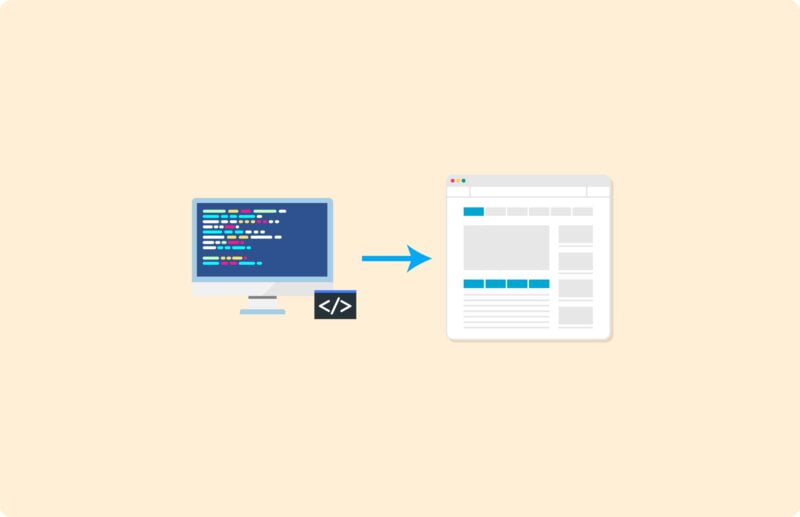Client side rendering vs serverside rendering: which is optimal for SEO?

Rendering is the process of converting raw data into a visual format that can be viewed and interpreted by users. In the context of Web development, this means converting code and content into a visual Web page that you see in your browser. A question I am frequently asked is, should we use serverside rendering or client side rendering for optimal serving of our content to GoogleBot? In this article, I take a closer look at it.
What is rendering?
Imagine you are reading a book, but instead of words you see only code. Not very useful, right? Rendering is the process that converts this code into an understandable and visual form, such as a Web page. It’s like having an interpreter translate a foreign language directly for you so you can understand and enjoy the story.

Why is it important for your website?
A well-rendered website ensures a smooth user experience. When pages load quickly and correctly, visitors stay longer and are more likely to take action, such as making a purchase or signing up for a newsletter. Moreover, search engines value fast and well-optimized websites, which can lead to better ranking in search results.
Serverside rendering (SSR): an overview
Serverside rendering, often abbreviated to SSR, is a technique in which the server takes responsibility for rendering the Web page before it is sent to the user.
How does SSR work?
When you visit a Web site that uses SSR, the server does the heavy lifting. The server retrieves the necessary data, processes the web page and then sends a fully rendered page to your browser. This means your browser has less work to do, which often results in faster load times.
Benefits of SSR for marketing and SEO
SSR offers some distinct advantages, especially from a marketing and SEO perspective:
- Speed: Because the server has already prepared the page, users can see the content faster.
- SEO: Search engines can more easily crawl and index SSR pages, which can lead to better visibility in search results.
- Reliability: SSR can ensure consistent display of your Web site regardless of the user’s device or browser.
When do you choose SSR?
If speed and SEO are top priorities for your website, SSR may be the right choice. It is also ideal for websites with a lot of dynamic content that changes frequently. However, as with any technology, there are drawbacks and considerations. It is important to keep your organization’s specific needs and goals in mind when making a choice.
Client side rendering (CSR): a dive into the technology
CSR, or client side rendering, is an approach where most of the rendering process takes place in the user’s browser, rather than on the server. This means that when a user visits a Web site, he or she first receives a “skeleton” of the page, then the content is dynamically loaded and displayed.
The operation of CSR
With CSR, your browser initially receives an almost blank Web page. Once this page loads, your browser retrieves the necessary data (usually via API calls) and fills the page with content. All of this happens on the user’s side, reducing the load on the server.
Why CSR may be attractive to certain websites
CSR offers a number of advantages that make it attractive to certain types of websites:
- Interactivity: Websites that require a lot of interactive elements or real-time updates, such as web apps, can benefit from CSR.
- Flexibility: CSR can be more easily modified and updated without reloading the entire page.
- Server load: Moving rendering to the client can reduce the load on the server, which can result in cost savings.
Considerations for marketing and SEO
While CSR offers benefits, there are also some considerations, especially from a marketing and SEO perspective:
- Visibility: Because search engines may see a page before it is fully rendered, this can affect how the content is indexed.
- Initial load time: Initial load time may be longer at CSR because the browser has to wait for all the content to render.
The impact on load time and user experience
The speed at which a website loads and the overall user experience are crucial factors that can affect visitor engagement and conversion.
Why speed and experience are critical to conversion
A slow website can frustrate visitors and even prompt them to leave the site before taking action. Studies have shown that even a one-second delay in load time can lead to a significant drop in conversions. So a smooth and fast user experience is essential to achieve your marketing goals.

How SSR and CSR affect load time and experience
- SSR: Because the page is already prepared by the server, users can often see the content faster, which can lead to a better first impression and user experience.
- CSR: Although the initial load time may be longer, subsequent page interactions can be smoother because only the changing content is loaded and not the entire page again.
The potential impact on SEO
SEO is a crucial part of any online marketing strategy. The way your website is rendered can have a direct impact on how search engines see and index your content.
How search engines deal with SSR and CSR
Search engines such as Google aim to present the most relevant and valuable content to users. How they perceive your content depends on your rendering method:
- SSR: Because the server provides a fully rendered page, search engines can more easily crawl and index it. This can lead to better visibility in search results, especially for websites with a lot of dynamic content.
- CSR: Although modern search engines are getting better at crawling CSR websites, it can take longer for the entire content to be indexed. This is because the search engine must wait for the client-side scripts to execute and the content to load.
Tips for optimizing your website regardless of choice
Regardless of whether you choose SSR or CSR, there are some universal SEO tips you can follow:
- Provide quality content: Good content remains king. Make sure your content is relevant, valuable and up-to-date.
- Optimize for mobile: A mobile-friendly website is essential, given the growing number of mobile users.

- Improve loading speed: Use tools such as Google PageSpeed Insights to identify and address bottlenecks.
- Use semantic HTML: This helps search engines understand the structure of your content.
Cost and maintenance: what does this mean for your budget?
When choosing between SSR and CSR, it is also important to consider the financial implications, both short- and long-term.
Investment costs for both technologies
- SSR: The initial setup for SSR can be more complex, which can lead to higher development costs. However, given the potential SEO benefits, this can be a worthwhile investment in the long run.
- CSR: Although the initial development costs for CSR may be lower, there may be additional costs for tools or services needed to address SEO challenges.
Maintenance and future modifications: what to expect
- SSR: Maintenance costs can be higher, especially if you make regular updates or changes to your Web site. However, the stability and consistency of SSR can provide long-term cost savings.
- CSR: While CSR websites can be more flexible in terms of updates, there may be additional costs for optimizing the user experience and SEO, especially if search engine algorithms change.
How do you make the right choice for your organization?
Choosing between SSR and CSR is not an easy decision. It goes beyond technology; it’s about finding the best solution that fits your organization’s needs and goals.
Factors to consider when choosing between SSR and CSR
- Purpose of website: Is your Web site primarily informational, or is it an interactive Web application? SSR can be ideal for content-driven sites, while CSR can shine for interactive apps.
- SEO priorities: If search engine visibility is top priority, SSR may have an edge because of better indexability.
- User experience: Consider the expected user experience. Do you want pages to fully load immediately, or is a dynamic, app-like experience more important?
- Maintenance and updates: How often do you expect to make updates or changes to your Web site? The flexibility of CSR can offer advantages here.
Roadmap for making an informed decision
- Define your goals: Understand what you want to achieve with your website.
- Analyze your target audience: Consider the technical capabilities and expectations of your visitors.
- Consult your technical team: They can provide insight into the implementation and maintenance costs of both options.
- Weigh the pros and cons: Look at both the short and long term.
- Test and evaluate: Consider a pilot project to see how a particular approach performs before making a full switch.
Closure: looking ahead
The world of web development and rendering is constantly changing. What is considered a best practice today may be obsolete tomorrow.
The future of rendering: what can we expect?
Hybrid rendering, which combines elements of both SSR and CSR, is gaining popularity. In addition, Web standards continue to evolve, and new technologies such as WebAssembly may change the way we think about rendering.
How do you stay informed and make sure your website stays up-to-date?
- Keep learning: Follow leading blogs, news sources and conferences in the web development world.
- Network: Talk to other CMOs and technical leaders to learn from their experiences and best practices. Of course, I am also happy to help you with an issue regarding CSR / SSR. For this, please contact me at.
- Schedule regular audits: Make sure your website is regularly evaluated for performance, SEO and user experience to ensure you are always one step ahead.






